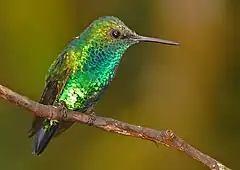| Chlorostilbon[1] | |||
| Gould, 1853[2] | |||
 Przedstawiciel rodzaju – złocik czarnodzioby (Ch. melanorhynchus) | |||
| Systematyka | |||
| Domena | |||
|---|---|---|---|
| Królestwo | |||
| Typ | |||
| Podtyp | |||
| Gromada | |||
| Podgromada | |||
| Infragromada | |||
| Rząd | |||
| Rodzina | |||
| Podrodzina | |||
| Plemię | |||
| Rodzaj |
Chlorostilbon | ||
| Typ nomenklatoryczny | |||
|
Chlorostilbon prasinus Gould, 1853 (= Trochilus pucherani Bourcier, 1843)[uwaga 1] | |||
| Synonimy | |||
|
| |||
| Gatunki | |||
| |||
Chlorostilbon – rodzaj ptaków z podrodziny kolibrów (Trochilinae) w rodzinie kolibrowatych (Trochilidae).
Zasięg występowania
Rodzaj obejmuje gatunki występujące w Ameryce (Kostaryka, Panama, Kolumbia, Wenezuela (włącznie z Margaritą), Aruba, Curaçao, Bonaire, Trynidad i Tobago, Gujana, Surinam, Gujana Francuska, Brazylia, Ekwador, Peru, Boliwia, Paragwaj, Urugwaj i Argentyna)[8].
Morfologia
Długość ciała 6,5–10,5 cm; masa ciała 2,1–4,5 g[8].
Systematyka
Etymologia
- Mellisuga: łac. mel, mellis „miód”, od gr. μελι meli, μελιτος melitos „miód”; sugere „ssać”[9]. Gatunek typowy: Mellisuga cayanensis Schäffer, 1789 (= Trochilus mellisugus Linnaeus, 1758); młodszy homonim Mellisuga Brisson, 1760 (Trochilidae).
- Chlorostilbon: gr. χλωρος khlōros „zielony”; στιλβων stilbōn, στιλβοντος stilbontos „świecący”, epitet planety Merkury (por. στιλβη stilbē „lampa”)[10].
- Chlorolampis: gr. χλωρος khlōros „zielony”; λαμπω lampō „świecić, błyszczeć”[11]. Gatunek typowy: Trochilus gibsoni Fraser, 1840.
- Panychlora: gr. πανυ panu „doskonale, niezmiernie”, od πας pas, παν pan „wszystko”; χλωρος khlōros „zielony”[12]. Gatunek typowy: Smaragditis euchloris Reichenbach, 1854 (= Trochilus alice Bourcier & Mulsant, 1848).
- Prasitis: gr. πρασιτις prasitis „szmaragd”, od πρασον prason „por”[13]. Gatunek typowy: Ornismya prasina Lesson, 1829 (= Trochilus mellisugus Linnaeus, 1758).
- Chrysomirus: późnołac. chrysos „złoto”, od gr. χρυσος khrusos „złoto”; łac. mirus „cudowny”[14]. Gatunek typowy: Trochilus chrysogaster Bourcier, 1843[uwaga 2].
- Merion: w mitologii greckiej Merion, był bratem Jazona, słynnym ze swego bogactwa[15]. Gatunek typowy: Chlorestes haeberlinii Reichenbach, 1854 (= Trochilus mellisugus Linnaeus, 1758); młodszy homonim Merion Schinz, 1825 (Cisticolidae).
Podział systematyczny
Do rodzaju należą następujące gatunki[16]:
- Chlorostilbon mellisugus (Linnaeus, 1758) – złocik szmaragdowy
- Chlorostilbon olivaresi Stiles, 1996 – złocik zielony
- Chlorostilbon gibsoni (Fraser, 1840) – złocik czerwonodzioby
- Chlorostilbon lucidus (Shaw, 1812) – złocik złotobrzuchy
- Chlorostilbon poortmani (Bourcier, 1843) – złocik krótkosterny
- Chlorostilbon stenurus (Cabanis & F. Heine, Sr., 1860) – złocik wąskosterny
- Chlorostilbon alice (Bourcier & Mulsant, 1848) – złocik wenezuelski
- Chlorostilbon russatus (Salvin & Godman, 1881) – złocik miedziany
- Chlorostilbon assimilis Lawrence, 1861 – złocik ogrodowy
- Chlorostilbon melanorhynchus Gould, 1860 – złocik czarnodzioby
Uwagi
Przypisy
- ↑ Chlorostilbon, [w:] Integrated Taxonomic Information System (ang.).
- ↑ J. Gould: A monograph of the Trochilidæ, or family of humming-birds. Cz. 5. London: Printed by Taylor and Francis, 1861, s. ryc. 355 i tekst. (ang.).
- ↑ J.Ch. Schäffer: Museum ornithologicum exhibens enumerationem et descriptionem avium quas nova prorsus ratione sibi paratas in museo suo asservat Jacobus Christianus Schaeffer. Ratisbonae: 1789, s. 41. (łac.).
- ↑ Cabanis i Heine 1860 ↓, s. 47.
- 1 2 Cabanis i Heine 1860 ↓, s. 49.
- ↑ Mulsant i Verreaux 1876 ↓, s. 63, 102.
- ↑ Mulsant i Verreaux 1876 ↓, s. 92.
- 1 2 K.L. Schuchmann: Family Trochilidae (Hummingbirds). W: J. del Hoyo, A. Elliott & J. Sargatal: Handbook of the Birds of the World. Cz. 5: Barn-owls to Hummingbirds. Barcelona: Lynx Edicions, 1999, s. 573, 575–577. ISBN 84-87334-25-3. (ang.).
- ↑ The Key to Scientific Names ↓, Mellisuga [dostęp 2020-03-24].
- ↑ The Key to Scientific Names ↓, Chlorostilbon [dostęp 2020-03-24].
- ↑ The Key to Scientific Names ↓, Chlorolampis [dostęp 2020-03-24].
- ↑ The Key to Scientific Names ↓, Panychlora [dostęp 2020-03-24].
- ↑ The Key to Scientific Names ↓, Prasitis [dostęp 2020-03-24].
- ↑ The Key to Scientific Names ↓, Chrysomirus [dostęp 2020-03-24].
- ↑ The Key to Scientific Names ↓, Merion [dostęp 2020-03-24].
- ↑ Systematyka i nazwy polskie za: P. Mielczarek & M. Kuziemko: Plemię: Trochilini Vigors, 1825 (wersja: 2020-03-01). [w:] Kompletna lista ptaków świata [on-line]. Instytut Nauk o Środowisku Uniwersytetu Jagiellońskiego. [dostęp 2020-03-24].
Bibliografia
- J. Cabanis & F. Heine: Museum Heineanum: Verzeichniss der ornithologischen Sammlung des Oberamtmann Ferdinand Heine, auf Gut St. Burchard vor Halberstadt. Cz. 3: Schrillvögel. Halberstadt: In Commission bei R. Frantz, 1860. (niem.).
- É. Mulsant & Verreaux: Histoire naturelle des oiseaux-mouches, ou, Colibris constituant la famille des trochilidés. Cz. 2. Lyon: Au Bureau de la Société Linnéenne, 1876, s. 1–327. (fr.).
- The Key to Scientific Names, J.A. Jobling (red.), [w:] Birds of the World, S.M. Billerman et al. (red.), Cornell Lab of Ornithology, Ithaca (ang.).
This article is issued from Wikipedia. The text is licensed under Creative Commons - Attribution - Sharealike. Additional terms may apply for the media files.